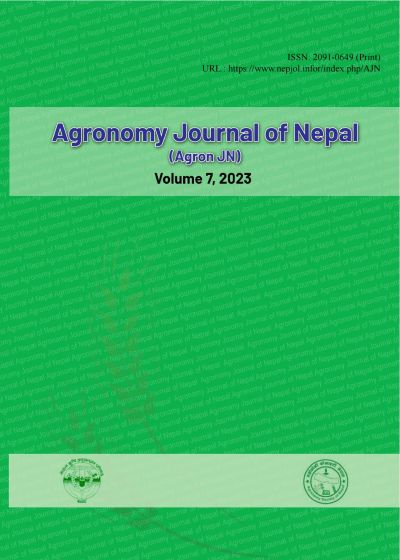Effects of Crop Geometry and Split Nitrogen Application on Spring Maize Growth, Yield Components and Yield in Digam, Gulmi, Nepal
DOI:
https://doi.org/10.3126/ajn.v7i1.62084Keywords:
Maize, Spacing, Split application of nitrogen, YieldAbstract
Maize (Zea mays L.) is a heavy nutrient feeder that needs optimum spacing and appropriate time to apply nitrogen to get maximum yield. A field study was carried out at Digam, Gulmi, from February to June 2022 to examine the impact of crop geometry and split application of nitrogen on spring maize in two factorial randomized complete block design (RCBD) with four replications. Factor A was the split application of nitrogen; (120 kg ha-1N at the time of sowing) and (60 kg ha-1N at the time of sowing + 30 kg ha-1N at knee height stage + 30 kg ha-1N before tasseling stage) and factor B included the three levels of spacing (75 cm x 25 cm, 60 cm x 25 cm and 50 cm x 25 cm). Plant height , stem girth , leaf number, cob girth, thousand grain weight, number of kernel rows per ear, number of kernels per row, and grain yield (3.45 MT ha-1) were all highest for treatment (60 kg ha-1N at sowing + 30 kg ha-1N at knee height + 30 kg ha-1N before tasseling). Likewise, plant height, leaf area index, cob length, cob girth, cob weight, thousand grain weight, number of kernels per row, grain yield (3.04 MT ha-1) and harvest index were highest in plant spaced at (75 cm x 25 cm), while the number of kernel rows per ear was highest in plants spaced at (60 cm x 25 cm). The lowest value of all parameters was found in plants at treatments; (120 kg ha-1N at the time of sowing) and (50 cm x 25cm). Similarly, the treatment (60 kg ha-1N at the time of sowing + 30 kg ha-1N at knee height stage + 30 kg ha-1N before tasseling stage) combined with spacing of (60cm x 25cm) was found to have a significant effect on grain yield (3.99 MT ha-1) which was statistically at par to the treatments, (60 kg ha-1 N at the time of sowing + 30 kg ha-1 N at knee height stage + 30 kg ha-1 N before tasseling stage) combined with spacing of (75 cm x 25 cm) (3.95 MT ha-1 ) . Thus, for the optimum and sustainable production of the spring maize, crop geometry of (75 cm x 25 cm) or (60 cm x 25 cm) can be recommended with three splits application of nitrogen at Digam, Gulmi.
Downloads
Downloads
Published
How to Cite
Issue
Section
License
Copyright (c) 2023 Agronomy Society of Nepal (ASoN)

This work is licensed under a Creative Commons Attribution-NonCommercial 4.0 International License.
ASON permits for free use, distribution and reproduction in any medium if the original work is properly cited and not used for commercial purposes.




